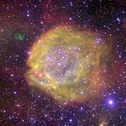Australian astronomers recently found a massive arc that sweeps around outside the other arms of the Milky Way. Astronomers are shocked that the feature has been overlooked until now.
 |
| The vast and marvelous universe |
A New Scientist article on May 9th, 2004, reported that astronomers, "made their discovery while mapping the distribution of hydrogen gas within the Milky Way... The structure consists of an arc of hydrogen gas 77,000 light years long and a few thousand light years thick running along the galaxy's outermost edge," and that it "sweeps around outside the other arms."
This means that the structural map of the Milky Way has to be redrawn.
On May 5th, AFP indicated that the New Scientist would report this shocking finding of Australian astronomers on May 8th, and that the 50-year-old map of the Milky Way would have to be redrawn because of this large extension of the galaxy.
Because it is out of the visible spectrum of light, the arm cannot be detected with telescopes. Astronomers at the Australia National Telescope Facility in Epping, New South Wales made this discovery while mapping the distribution of hydrogen gas within the Milky Way. "Most of the Milky Way is obscured by clouds of dust. But hydrogen emits radio waves which pass through the interstellar dust clouds." This is how it was detected by radio telescope.
Naomi McClure-Griffiths, who leads the study, said, "The arc could be a tendril that once joined up with another spiral arm."
* * *
You are welcome to print and circulate all articles published on Clearharmony and their content, but please quote the source.










 more ...
more ...